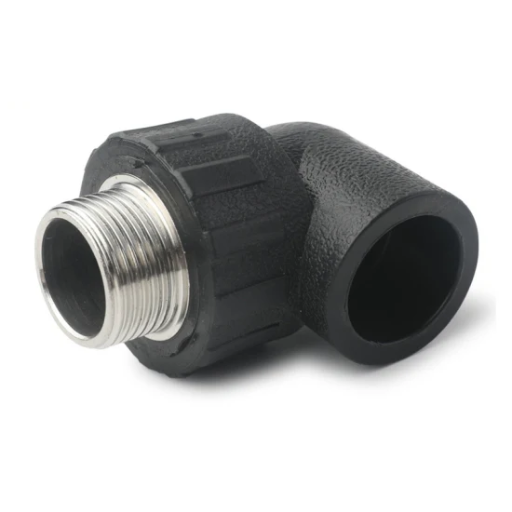This comprehensive guide will delve into the world of HDPE (High-Density Polyethylene) socket fusion male elbow couplers, which are a vital component in building robust and secure pipe systems. We will examine what HDPE materials offer, such as their corrosion resistance and durability, and why one should use socket fusion technology for jointing applications. The paper also provides insights on how these male elbow couplers can be installed, the best practices involved, and where they are commonly used so that our readers can make informed decisions when dealing with HDPE pipes. Whether you are an advanced expert or just an amateur needing some essential insight on the subject, this guide aims to provide an understanding of the topic for successful implementation in your projects.
What is a HDPE Socket Elbow Male Coupler?
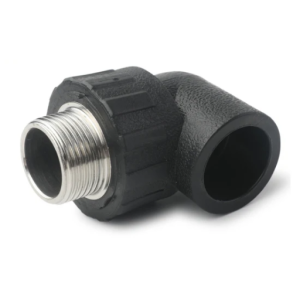
Image source: https://nbkingwin.en.made-in-china.com/
A High-density polyethylene socket elbow male coupler is a connecting fitting designed to join two pipes with a 90-degree angle. This type of coupling has a socket end, which allows for the insertion of the conduit while maintaining its integrity using socket fusion technology, thereby promoting solid connections that do not leak. This kind is resistant to chemical attack and environmental stress cracking, making it ideal for residential and industrial applications where long-term life expectancy and endurance are required.
Definition and Purpose of HDPE Socket Elbow Male Coupler
To understand it better, I think an HDPE socket elbow male coupler can be defined as a special connector that unifies two pipes at an angle predetermined at 45 or 90 degrees, thus enabling flow redirection in a piping system. The key objective of this adaptor is to ensure firm joints that cannot burst under any form of load but retain water-tightness permanently. It is constructed from high-density polyethylene and is famous for its excellent strength characteristics, resistance against rusting, and adaptability in residential and commercial setups. This makes them highly desirable fittings because they provide sturdy connection points that improve all HDPE pipelines’ overall toughness and performance capabilities, hence increasingly being adopted by plumbers for various construction and industrial activities.
Key Components of HDPE Socket Elbow Male Coupler
The main constituents of a male coupler for HDPE socket elbow are the socket end, body, and male end.
- Socket End: This section is designed to snugly receive the end of a pipe, which helps prevent leakage. The socket is often tapered or flared to allow easier pipe insertion.
- Male End: The male coupler’s end is usually shaped to fit into a corresponding female fitting or duct. It allows flexible connections within the piping system.
- Body: The coupler’s body is made from high-density polyethylene (HDPE), which is outstandingly strong and resistant to UV radiation and chemicals. Its solid structure provides durability, making it applicable in many areas, such as water supply and drainage systems.
These components work together to manage smooth flow through HDPE pipes safely and effectively.
Common Applications of HDPE Socket Elbow Male Coupler
In my experience, HDPE socket elbow male couplers are used for various purposes across different industries. They are commonly found in water distribution systems where their secure joints ensure the uninterrupted flow of clean drinking water. I have also seen this type of coupler being applied in agricultural irrigation systems, providing efficient water delivery to crops under adverse environmental conditions they can withstand. In construction, these fittings are sometimes integrated into stormwater management structures, facilitating effective handling of stormwater and wastewater. Furthermore, due to their corrosion resistance capabilities, they can be used in industrial settings such as handling chemicals or gas distribution.
How do you install an HDPE socket elbow male coupler?
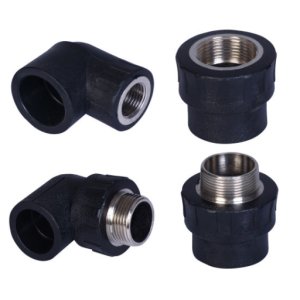
Installing an HDPE socket elbow male coupler is a simple process that requires few tools and equipment. First, you will need certain things at hand, including an HDPE pipe, the male coupler itself, a pipe cutter, and a fusion welding machine or socket welding equipment, depending on the type of installation.
- Preparation: Measure and cut the HDPE pipe to the desired length using a pipe cutter, ensuring the cut is clean and straight.
- Cleaning: Clean both ends of the pipes and the inside of the socket to remove dirt or debris that may hinder connection.
- Alignment: Align the male end of the coupler with the female fitting or elbow to which it connects. Ensure that both ends are correctly seated.
- Joining: Connect this device with your welding machine using electrofusion according to the manufacturer’s manual. In the case of socket welding, apply suitable glue or heat as mentioned and push in place until this coupling firmly bonds the parts together.
- Curing: Allow the recommended time for curing while ensuring no interference during this period.
Simply following these steps would guarantee the strong and long-lasting installation of an HDPE socket elbow male coupler for its intended purpose.
Preparation for HDPE Socket Fusion
I follow a systematic approach to ensure a successful connection when preparing for HDPE socket fusion. First, I gather my materials and tools, including HDPE pipes; then, I find myself a good socket fusion machine and necessary personal protective equipment. From here on, I begin carefully examining them for any damages and possible contaminations before checking whether they are clean or dry. To make correct fusions, my cuts on pipe ends should be at right angles using pipe cutters while also lightly bevelling their edges to fit into a coupling better easily. Moreover, I set the proper temperature and heating time on my fusion machine, achieving the requisite heat. Such actions allow me to get a solid and reliable HDPE joint.
Step-by-Step Installation of HDPE Male Elbow
- Preparation: You must gather all the necessary materials, including HDPE pipes, male elbow fittings, and different joining methods such as socket welding or electrofusion. In addition, you need to have the correct tools and personal protective gear.
- Pipe Inspection: Examine the HDPE pipes for cuts, contamination, or other defects. The surface of the pipe may require cleaning before a firm attachment can be made.
- Cutting and Chamfering: Using a pipe cutter, trim the ends of your HDPE pipe into a square shape. Slightly round off the edges to ensure they fit well with a male elbow.
- Alignment: Have one side of your MALE ELBOW aligned with a female joint or elbow in which it is intended to connect while ensuring that both sides are appropriately seated.
- Joining Process: Use the manufacturer’s specification to apply appropriate adhesive/heat during socket welding. The coupling is connected to the fusion machine through its unique instructions.
- Bonding: Push this elbow or coupler into its position such that there is 100% bonding achieved between both parts.
- Curing Time: Let this joint sit undisturbed during the curing time recommended by the manufacturer for installation strength/integrity purposes only.
By following these systematic procedures, one can install strong, reliable, and resilient HDPE elbows for men in various applications.
Common Installation Mistakes to Avoid
When fixing HDPE male elbows, there are a few common mistakes that should be taken into consideration during the process to ensure a successful project:
- Insufficient Pipe Preparation: Failing to inspect and clean pipes thoroughly can result in poor bonding and leaks. Both ends of the pipes must be clear of any impurities.
- Wrong Alignment: I have found out that not aligning the fittings correctly puts stress on joints, which may cause premature failure. Ensuring that the male elbow fits tightly and is correctly oriented is vital.
- Ignoring Curing Time: I often feel like speeding up this process by not allowing enough time for curing adhesives or welding. In such cases, the adhesive becomes weak at its joint, so one must stick strictly to the manufacturer’s recommended curing times.
This way, installation is made more efficient while connections become more reliable.
What are the Benefits of Using HDPE Socket Fusion Fittings?
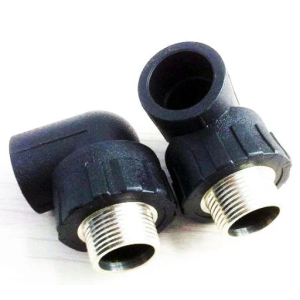
HDPE socket fusion fittings have many advantages, making them preferred for piping installations. First, they deliver a tight and permanent joint by melting and merging the pipe and fitting it together, forming an uninterrupted link resistant to leaking. Besides, HDPE is highly resistant to corrosion or chemicals, increasing its lifespan in different environments. Additionally, these processes are effective since most instances allow quick installation without other tools or complicated assembly procedures. Lastly, HDPE socket fusion fittings can withstand various pressures and temperatures due to their flexibility, thus reducing the chances of joint collapse while being used in wide application areas.
Durability and Strength of HDPE Pipe
HDPE pipes are widely recognized for their fantastic toughness and strength, which makes them a dependable choice in diverse applications. They have been made to withstand high-pressure conditions and remain unaffected by cracking, impact, or deformation in severe environmental conditions. The molecular structure of HDPE allows it to maintain performance over time, ensuring a long service life with minimal maintenance. According to the leading industry sources, these pipes exhibit excellent resistance to corrosion and chemical leaching; hence, they are suitable for delivering drinking water and sewage without degrading its quality. Further, the flexibility of HDPE provides room for resilience; thus, it can be adapted in different installation scenarios where joint failures are not an issue. Many infrastructure projects rely on HDPE piping systems because of their durability and strength.
Cost-Effectiveness of HDPE Socket Fusion Fittings
In my experience, I have found out that HDPE socket fusion fittings offer an economical solution for pipelines. While it might seem like a heavy investment at first sight compared to other materials, it will pay off handsomely in the long run due to lower maintenance costs and reduced frequency of repairs needed. Hence, replacement requirements can be lessened over time due to durability and environmental resistance considerations, allowing budget allocations elsewhere for critical developments. Also associated with socket fusion is a quick installation process, which reduces labor costs, making the value offered by HDPE fittings more attractive overall. As such, when considering initial expenditure and subsequent running costs, HDPE socket fusion fittings are financially viable, regardless of the infrastructure project type.
Environmental Benefits of Polyethylene
Some key benefits from polyethylene, particularly HDPE, were discovered upon researching its environmental advantages. Firstly, HDPE can be recycled extensively, ensuring a circular economy and reducing plastic waste. Many communities have established programs that specifically recycle these items made from high-density polyethylene to promote responsible disposal actions. Furthermore, they are more robust than other materials used for the same purposes, besides having relatively more minor lifecycles that minimize too-soon replacement and excessive use of such natural resources. In addition, compared to heavier alternatives, polyethylene is lightweight; hence, it requires less energy for transportation purposes, therefore low transport emissions as these materials are moved by less power. Altogether, the sustainability of HDPE is supported by all of these aspects and shows its potential to reduce environmental impacts in infrastructure projects.
What Types of HDPE Pipe Fittings Are Available?
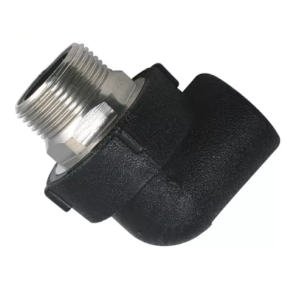
HDPE pipe fittings come in varied types for different applications and projects that may be required. Common types include;
- Elbows: These bend the direction of the pipeline, while others can be 45° and 90° angles.
- Tees: Tees allow for an offshoot on the main line in the exact and reduced sizes.
- Couplings: Joins two pipes together; thus, it forms a joint that is tight and water-free.
- Reducers: Changes in pipe flow rates require a larger or smaller diameter, depending on the application.
- Caps And Plugs: They enclose the extremities of tubes to seal the system.
- Flanges: Bolts hold these pipes firmly when connecting them to other equipment. Additionally, they give stability to the connection with pipes.
These fittings have been designed to perfectly fit HDPE piping systems, ensuring toughness and longevity. Hence, they are applicable in various sectors, including water supplies and industrial areas.
Overview of HDPE Butt Fusion Fittings
HDPE butt fusion fittings are necessary components for HDPE pipeline systems as they provide a robust and seamless connection between pipes. This technique involves heating the ends of the pipe parts and fitting them up to certain temperatures before bringing them together to form one joint. This fusion ensures that joints have high mechanical strength and do not leak at all points, making it useful in many areas, including water and gas distribution. Butt fusion fittings can be found in different designs like elbows that change the angles; tees meant to increase connections, among others, so that each user can adapt his particular system design requirements. Benefits stemming from employing butt fusion include reduced threat of leakage, improved structural soundness, and potential for manufacturing continuous lengths without having any joints, thereby boosting overall system performance plus reliability levels too.
Comparison Between Compression Fittings and Electrofusion
From what I have observed, whether to choose compression fittings or the specific situation determines electrofusion. Since they don’t need any special tools, it is less complicated to install compression fittings, and it takes a shorter time; all you have to do is tighten them so they can hold together through a mechanical seal. In cases where smaller projects are involved, or repairs need immediate attention, this can be an advantage. On the other hand, electrofusion fittings offer a more permanent and secure means of joining since they are fused using electric current. This results in a joint that doesn’t leak and has better strength properties; hence, it is appropriate for use under high-pressure applications, according to my opinion. However, customers usually consider issues like the project specifications, environmental conditions, and long-term dependability before choosing between them.
Specialty Fittings: 90 Degree Elbow and Reducer Tee
Ninety-degree elbow reducer’s tees form essential components of pipelines as these allow change of direction and pipe diameter, respectively. A 90-degree elbow permits a sharp bend in a pipeline, enabling efficient flow containment without creating significant pressure drop. A reducer tee also acts as a meeting point for different-sized pipes while maintaining smooth flow. These products can be made from PVC, HDPE, or steel, thus making them suitable for home and industrial use. Flow rates, pressure ratings, and compatibility with existing piping materials must be considered when selecting such fittings.
How to Choose the Right HDPE Socket Fusion Male Coupler?
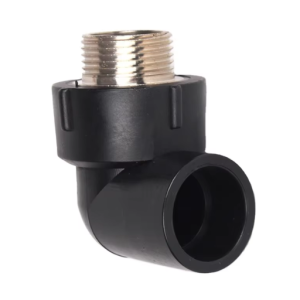
Many factors should guide someone when looking for an HDPE socket fusion male coupler that has been chosen correctly. The first thing one should consider is whether the size of the coupler will fit into the pipe he wants to be attached since, if not, there will be no connection at all, leading to insecurity (Wolferstan et al.). Next comes checking on how much pressure both the intended application and coupler can take because you want something that doesn’t burst due to excessive loads imposed by operations carried out in it (Davison & Tegtmeyer 30). Moreover, the HDPE type must also be considered, as sometimes specific applications demand particular grades or structural attributes. Lastly, reputable brands have better quality certifications and manufacturer specifications, which they give out before customers start buying. Therefore, if all these things are taken care of while purchasing one, a coupler that can do what your project requires can easily be found.
Factors to Consider: Pressure Ratings and Material Grade
Pressure ratings are imperative when selecting an HDPE socket fusion male coupler. The two types of couplers are not equal in terms of pressure rating. The listed pressure rating is typically in pounds per square inch (psi), and it should be checked against the plumbing system’s operating conditions to avoid failure.
Moreover, the material grade used significantly impacts how long-lasting and efficient these fittings will be. There are various levels of HDPE for different environments and applications, such as high-density polyethylene (HDPE) with a higher molecular weight, which can withstand stress cracking and give flexibility; therefore, it is more appropriate for harsh environmental conditions. Thus, reviewing manufacturer specifications to ascertain the material grade and its corresponding applications is essential in ensuring that the coupler can withstand the intended use while providing longevity and reliability.
Selecting the Proper Male Thread Type
To select the correct male thread type for HDPE socket fusion couplers, I first consider if the thread is compatible with my plumbing application. The most common types of threads are NPT (National Pipe Thread) and BSP (British Standard Pipe). Tapered NPT threads form a tight seal for high-pressure applications, while parallel BSP threads may be employed in low-pressure systems. I also pay attention to the dimensions and specifications of existing fittings to ensure a good match. Additionally, I check for manufacturer guidelines and industry practices because observing these helps avoid installation problems. Eventually, the choice depends on my project’s specific needs and the environmental conditions for using the fixtures.
Importance of Supplier Reputation and Certification
When sourcing HDPE fittings, supplier reputation, and certification are critical to ensuring quality and reliability. Trustworthy suppliers usually emphasize superior manufacturing processes, environmental compliance, and safety standards. Certification from recognized organizations like ISO or ASTM indicates that goods meet strict industry requirements, significantly reducing the chances of failures or faults. Moreover, consumer feedback or testimonials give insights into the service quality of such suppliers and their products’ performance under normal operating circumstances. As a result, focusing on verified credentials and having strong reputations will enable experts to purchase adaptable components that satisfy their purposes for development in the future.
Reference sources
- ASTM International – Standard Specification for Polyethylene (PE) Plastic Pipe and Fittings Materials
https://www.astm.org/d3350-21.html
This document provides comprehensive specifications for polyethylene materials used in piping systems, including socket fusion male elbow couplers. Understanding the material standards and quality requirements applicable to industrial applications is crucial. - Performance Pipe – Fittings and Fabrications Designed and Engineered for High-Density Polyethylene Pipe
https://www.cpchem.com/what-we-do/solutions/performance-pipe
This document outlines various HDPE fittings, including socket fusion male elbow couplers. It provides detailed guidance on the specifications, standards, and installation practices, ensuring reliable performance in industrial piping systems. - ASME (American Society of Mechanical Engineers) – B31.3 – Process Piping
https://www.asme.org/codes-standards/find-codes-standards/b31-3-process-piping
This standard provides requirements for process piping systems, including using HDPE Socket Elbow Male Couplers in various industrial applications.
Related Articles: Technical Notes of HDPE Socket Elbow Male Coupler



